Here I am going to cover the 10 Unidentified tribal communities of world. These Tribes are mostly found in Odisha, Brazil, Peru, Colombia, Venenzuela, North Sentinel. These Tribal Communities are Mostly Unknown from the World and Media. Here in this Blog I am specifically focused on their Origin, Location, Customs & Traditions, Lifestyle, Food and more. This Blog Will Definitely give you some insights into their world.
1. KONDA
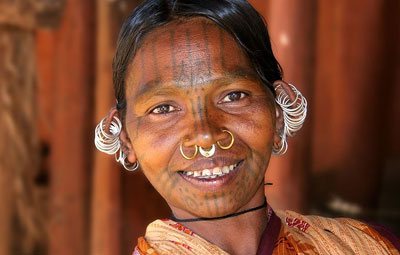
ABOUT
Kond is one of the largest tribe in Odisha who worship hills, nature, and streams. The people of Kondh tribe have an essential knowledge of the mountains, trees, forest, and plants. Khonds (also spelt Kondha, Kandha etc.) are an indigenous Adivasi tribal community in India. Traditionally hunter-gatherers, they are divided into the hill-dwelling Khonds and plain-dwelling Khonds for census purposes; All the Khonds identify by their clan and usually hold large tracts of fertile land but still practice hunting, gathering and slash-and-burn agriculture in the forests as a symbol of their connection to and ownership of the forest. Khonds speak the Kui and Kuvi languages and write them in Odia script.
LOCATION
They are located in the Niyamgiri hills in the state of Odisha in India. Niyamgiri is a hill range spread over 250 km2 which falls under the Rayagada and Kalahandi District in south-west Odisha, India. It is an area containing densely forested hills, deep gorges and cascading streams. Its highest point is the mountain known as Niyamgiri or Niyam Dongar, at a height of 1,306m.
CUSTOMS AND TRADITION
a) The Khonds were historically animists. Traditionally the Khond religious beliefs were syncretic combining totemism, animism, ancestor worship, shamanism and nature worship. Kondhs have several priests such as Jani, Matiguru, Dehuri, Bahuk and Jhankar. They perform different rituals. They worship mountain, river, Sun, Earth.
b) They perform many rituals such as Jhagadi or Kedu or Meria Puja, Sru Penu Puja, Dharni Penu Puja, Guruba Penu Puja, Turki Penu Puja, Pitabali Puja and Khambeswari and Maheswari Puja. Matiguru is priest who worship earth who perform Dharani Puja’, ‘Guruba Puja’, ‘Turki Puja to appease Dharni (earth). The Khonds gave highest importance to the Earth goddess, who is held to be the creator and sustainer of the world.
FOOD
They have expert knowledge of their forests and the plants and wildlife they hold. From the forests they gather wild foods such as wild mango, pineapple, jackfruit, and honey. The Tribes use to consume seasonal Food like Mandia, Rice, Mushroom, Salpa Powder, Ripe Mango, Jackfruit seed, dry fish, few flesh foods.
2.BONDA
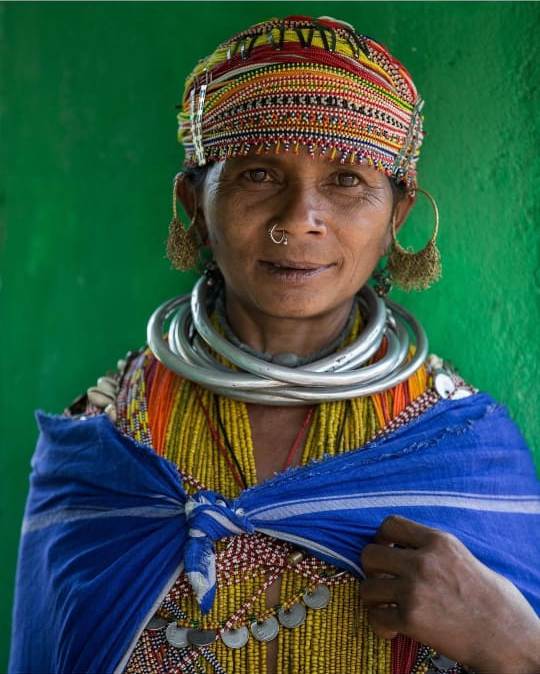
ABOUT
One of the country primitive tribes living in the quaint hills in Malkangiri district, Odisha. The unique culture, enthralling customs, and typical attire make Bonda the most popular tribal community in the state. The Bonda people are a tribal people who currently live in the hills of Odisha’s Malkangiri district in India. There are two different Bonda tribes: the Upper Bondas with a population of 6,700 who are the most isolated from mainstream Indian society, and the Lower Bonda with a population of 17,000.
LOCATION
The Bonda are a Munda ethnic group approximately 12,000 (2011 census) who live in the isolated hill regions of the Malkangiri district of southwestern Odisha, India, near the junction of the three states of Odisha, Chhattisgarh, and Andhra Pradesh.
CUSTOMS AND TRADITIONS
a) The Bonda are generally semi-clothed, the women wear thick silver neck bands. The Bonda attire is explained in a legend relating to the Ramayana. According to it, some Bonda women chanced upon Sita who was bathing at a pond in the Bonda hills and, seeing her naked, they sniggered. Their torsos are covered in strings of colourful beads. Bonda women also wear metal rings that cover their necks and bangles on their arms. Since Bonda women hunt and forage for food in the forest it is thought that these ornaments have a function of protecting them from injuries and attacks by wild animals. Bonda women have their heads shaved and adorned with two types of headbands, called turuba and lobeda.
b) The Bondas are primarily animistic but also include Hindu gods in their pantheon.
Unlike the Hindus, they consume beef and meat of dead animals. They associate themselves with Ramayana hero Lord Rama whose sword is their supreme deity i.e. Patkhanda Mahaprabhu, situated in a Great Banyan Tree. the Sun and the Moon are worshipped with a number of demigods residing in different streams, forest, swiddens, villages, homes.
FOOD
Each Bonda household used to have a kitchen garden, now they buy vegetables from the market. Even their eating habits have changed. Before, they used to eat beef and pork, and they used to domesticate cows for this reason.
3.SANTHALS
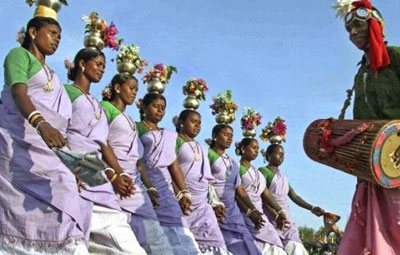
ABOUT
The great fighters during British regime in India and also most fun-loving ones are the people of the third largest tribe of India – Santhal. Music and dance are activities which are loved the most by Santhals. Santhal, also spelled Santal, also called Manjhi, ethnic group of eastern India, numbering well over five million at the turn of the 21st century. Their greatest concentration is in the states of Bihar, Jharkhand, West Bengal, and Orissa, in the eastern part of the country. Some 200,000 also live in Bangladesh and more than 10,000 in Nepal. Their language is Santhali, a dialect of Kherwari, a Munda (Austroasiatic) language.
LOCATION
Santals are the largest tribe in the Jharkhand and West Bengal state of India in terms of population and are also found in the states of Odisha, Bihar and Assam. They are the largest ethnic minority in northern Bangladesh’s Rajshahi Division and Rangpur Division.
CUSTOMS AND TRADITIONS
a) The traditional dress pattern and personal adornment of the Santal distinguish them from the other
communities. The male members wear hand loom loin cloth (kacha), banion, shirts and napkin(gamchha)
and women wear green or blue check saree (jhelah).The Santal women are fond of wearing ornaments like pankatha (hairpin), sikimala (coin necklace), baju(armlet), sankhachudi (wristlet), satul (bangles), painri (anklets). Tattooing has become an obsolete past tradition.
b) In the Santal religion, the majority of reverence falls on a court of spirits (Bonga), who handle different
aspects of the world and who are placated with prayers and offerings in order to ward off evil influences.
The Bonga are intermediaries between noa puri (visible world) and hana puri (the invisible reality), the abode of a Creator. This creator is variously called Marang Buru (great mountain) or Thakur Jiu (life giver), and is the “cause of all causes,” making the Santal religion, in a deep sense, monotheistic as well as pantheistic.
FOOD
Rice is their staple food. Usually they take watered rice (baskemandidaka) with boiled green leaves
(alahkorha) and vegetable curry. They consume vegetables like brinjal (bengal), pumpkin (kahanda), papaya (jada), ladies finger (bhundi), tomato (bilati), sweet potato (sankarkenda), etc. and the non-veg foods like fish (haku), meat (zil), crab (katkom) and dry fish (rahalhaku).
4.GONDS
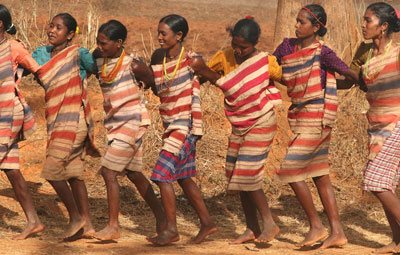
ABOUT
A warrior tribe that resides in the hills of Koraput, Balangir, Sunderbagh, Kalahandi, and Sambalpur is Gonda. Not just Indias but Gond is one of the largest tribes in South Asia. Gond, group of aboriginal peoples (now officially designated as Scheduled Tribes) of central and south-central India, about two million in number. The majority speak various and, in part, mutually unintelligible dialects of Gondi, an unwritten language of the Dravidian family. Some Gond have lost their own language and speak Hindi, Marathi, or Telugu, depending on which is dominant in their area.
LOCATION
They live in the states of Madhya Pradesh, Maharashtra, Telangana, Andhra Pradesh, Bihar, and Odisha.
CUSTOMS AND TRADITIONS
a) Gonds also pay homage to the Gods of household, Gods of Cattle, Gods of fields. Animal sacrifice on the religious occasions is the common practice among the Gonds. Customs and Festivals : Gonds fair and festivals are influenced from the Hindu traditions. Keslapur Jathra is the important festival of the Gonds. In this festival they worship the snake deity called Nagoba, whose temple is found in the Keslapur village of Indervelly mandal of Adilabad district.
b) Gusadi dance is the most famous dance perfomed by the Gonds. It is performed by wearing head gears decorated with the peacock feathers. Madai is the another major festival celebrated among the Gonds. It is the festival when Gonds meet their relatives settled in various parts of the country. During this festival they also sacrifice goat beeath the sacred village tree to appease the tribal Goddess. They also celebrate Hindu festival called Dusshera.
FOOD
Gond diet has two staple millets – askodo and kutki. They are often day meals in the form of broth and night meal in the form of dry cereal with vegetables grown in gardens or picked up from forests. One cereal that is a luxury for them is Rice.
5.PARAJAS

ABOUT
Parajas are one of the well known major tribes of Odisha. The population of the tribe as per 2011 census in Nabarangpur district is 74,253. The Parajas seem to have been inhabiting this country from about the 2nd century of the Christian era. (District Gazetteers, Koraput, 1966). They say that their original home is ‘Bastaria’ as they have migrated from Bastar area of Madhya Pradesh (now Chatisgarh). Their mother tongue Porji is a form of Gondi belonging to the Dravidian family of languages which varies according to local tongues like Odia or Telugu.
LOCATION
Paroja tribes are mostly found in Koraput, Semiliguda, Pottangi, Laxmipur, Lamataput, Nandapur, Dashmantpur, Jeypore, Boipariguda, Kundra and Borigumma block of the district of Odisha.
CUSTOMS AND TRADITIONS
a) Dress and Ornaments– Little children hardly wear any cloth but after reaching seven to eight years of age they wear a small piece of discarded clothing (koupin) which barely covers their loins.
Adult males generally wear a small napkin or loin cloth (langoti / kachha) leaving the entire body completely naked.
Females wear loom made coarse sarees purchased from local weavers or from weekly markets, which cover up to the knees and tied in a knot in the left shoulder.
Women love to adorn themselves with varieties of ornaments to beautify themselves.
They put kanjika, sikidiguba and suju on their head, phasi and jilligut and rings on their earlobes, dandi on the helix of their nose and mundra on their nasal septum. In their society use of nose and ear rings is a customary practice for the married women..
b) Festival, Dance and Music- Paraja observe many seasonal festival with pomp and ceremony round the year. Among these, the important ones are Asadha Parab, Nuakhia, Diali Parab, Push Parab, Chaita Parab etc. Dhemsa dance, Khadumara dance, Dungdunga dance are some of the popular dance of the tribe.
The male members use the musical instruments like dhola, tamaka, dungdunga & mahuri. Their dance, music & songs are highly inspired by the beautiful elements of nature like the Sun, the Moon, the sky, the wind, the rain and the trees, streams, flowers, birds and animals etc.
c) Culture and Livelihood- The tribal economy is driven essentially by activities around the jungle. Most communities were hunter-gatherers, who also did some fishing as a source of livelihood. Agriculture and farming are also practised with the slash and burn technique or shifting cultivation.
The local haat (market) is the best time to see various tribes together.
Haats are held on specific days at specific venues and offer tribals a platform to buy provisions or livestock or sell their wares.
FOOD
The staple food of the Paraja is rice and is supplemented with millets, maize, pulses, seasonal fruits, roots and meat, egg, fish etc.
Some of the important trees of the Paraja are mahula, salap, kendu, mango etc.
They collect flowers, juice and fruit from these trees. They also use (mohua liquor) mahuli, landa (mandia liquor), salap (palm liquor) etc. They also eat “mouse” after the harvest period.
6. SENTINELESE

ABOUT
The Sentinelese are the most isolated tribe in the world, and have captured the imagination of millions. They live on their own small forested island called North Sentinel, which is approximately the size of Manhattan.
a) Incidents of Discovery– In November 2018, John Allen Chau, an American man, was killed by members of the Sentinelese tribe. In 2006, two Indian fishermen, who had moored their boat near North Sentinel to sleep after poaching in the waters around the island, were killed when their boat broke loose and drifted onto the shore. Most of what is known about the Sentinelese has been gathered by viewing them from boats moored more than an arrows distance from the shore and a few brief periods where the Sentinelese allowed the authorities to get close enough to hand over some coconuts.
LOCATION
The Sentinelese are an uncontacted tribe living on North Sentinal Island, one of the Andaman Islands in the Indian Ocean.
CUSTOMS AND LIVING STYLE
a) The Sentinelese hunt and gather in the forest, and fish in the coastal waters. Unlike the neighbouring Jarawa tribe, they make boats – these are very narrow outrigger canoes, described as ‘too narrow to fit two feet in’. These can only be used in shallow waters as they are steered and propelled with a pole like a punt. They have two different types of houses; large communal huts with several hearths for a number of families, and more temporary shelters, with no sides, which can sometimes be seen on the beach, with space for one nuclear family.
b) The women wear fibre strings tied around their waists, necks and heads. The men also wear necklaces and headbands, but with a thicker waist belt. The men carry spears, bows and arrows. There is no reason to believe the Sentinelese have been living in the same way for the tens of thousands of years they are likely to have been in the Andamans. They now use metal which has been washed up or which they have recovered from shipwrecks on the island reefs. The iron is sharpened and used to tip their arrows.
FOOD
The Sentinelese are hunter-gatherers. They likely use bows and arrows to hunt terrestrial wildlife and more rudimentary methods to catch local seafood, such as mud crabs and molluscan shells. They are believed to eat a lot of molluscs, given the abundance of roasted shells found in their settlements.
7.TOROMONA
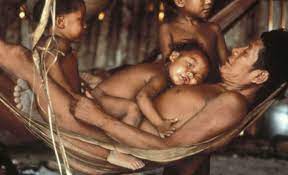
ABOUT & LOCATION
The Toromona are an uncontacted people living near the upper Madidi River and the Heath Rivers in northwestern Bolivia. The government has created an “exclusive, reserved, and inviolable” portion of the Madidi National Park to protect the Toromona.
CUSTOMS AND TRADITIONS
The Toromona language is a Tacanan language. The Toromona Tribes are the most oblivion tribe in the north of bolivia. They are mostly Naked and are hunterers. They rely on Seafood meat and flesh of Animals of rodents.
HISTORY
During the Spanish colonization, Spaniards found it difficult to settle down in the area of the Amazon, where their main goal was to find a secret place called Paititi, an alleged hiding place of the Incas’ biggest treasures that the Incas concealed from the Spaniards. There are some historical records that confirm that the Incas sealed tunnels in ritual ceremonies. Father Miguel Cabello de Balboa wrote about a city of gold and he described Paititi as a place protected by warrior women; he also mentioned the Toromona tribe with notes that it had no mercy in killing.
8.TOTOBIEGOSODE
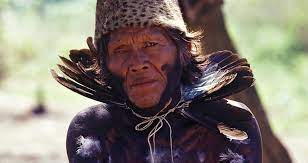
ABOUT
Approximately 100 Ayoreo people, some of whom are in the Totobiegosode tribe, live uncontacted in the forest.
LOCATION
They are the last uncontacted peoples south of the Amazon basin, and are in Amotocodie.
LIFESTYLE AND CUSTOMS
They are nomadic, and they hunt, forage, and conduct limited agriculture. Threats to them include rampant illegal deforestation. Brazilian company Yaguarete Porá S.A. is converting thousands of hectares of the Ayoreo-Totobiegosode tribe’s ancestral territory into cattle ranching land.
FOOD
They are both Hervivorous and Carnivorous. They depend on the water and pulp of trees of mid size plants to quench thirst. They hunt mid size animals, fishes of river and rodents to trap them.
9.MASCHO-PIRO

ABOUT & LOCATION
The Mashco-Piro are nomadic Arawak hunter-gatherers who inhabit Manú National Park in Peru. In 1998, the International Work Group for Indigenous Affairs estimated their number to be around 100 to 250. They speak a dialect of the Piro languages.
CUSTOMS AND LIFESTYLE
The Tribes are mostly hunt gatherers. They are mostly naked or where leaves of banyan tree, trees pulf. The mostly rely on sea animals, river animals, Birds, Crabs etc.
OTHER SIMILAR GROUPS OF TRIBE
Other groups include the Machiguenga, Nanti, Asháninka, Mayoruna, Isconahua, Kapanawa, Yora, Murunahua, Chitonahua, Mastanahua, Kakataibo, and Pananujuri. Many of them speak dialects of Panoan languages.There are five reserves for uncontacted peoples.
10.CARABAYO
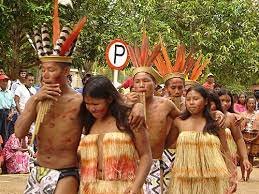
ABOUT
The Carabayo (who perhaps call themselves Yacumo) are an uncontacted people of Colombia living in at least three long houses, known as malokas, along the Rio Puré (now the Río Puré National Park) in the southeastern corner of the country. The Carabayo are also known as the Aroje or Yuri people. They are known as the Aroje to the Bora people. Maku and Macusa are pejorative Arawak terms applied to many local languages, not anything specific to Carabayo.
LOCATION
They live in the Amazonas Department of Colombian Amazon rainforest, near the border with Brazil. They share the protected National Park with the Passé and Jumana people. The Carabayo language appears to be a member of the Tikuna–Yuri family.
FOOD
The Tribe mostly depends on rodents, lake and river animals and trees pulp for their food.
LEGAL PROTECTION
In December 2011, President Juan Manuel Santos signed legal decree #4633, which guarantees uncontacted peoples such as the Carabayo the rights to their voluntary isolation, their traditional territories, and reparations if they face violence from outsiders.
Conclusion
So, In this Topic I am able to cover the top 10 Unknown Tribal Communities of world and gave a clear Insight into their world of living, History, Customs and Traditions, Food and more. I think you guys will really be fascinated to know these facts. If you Guys know any other most inhabited tribal community, do let me know in the comments section.